Jim Crow Museum
1010 Campus Drive
Big Rapids, MI 49307
[email protected]
(231) 591-5873
Could you please give a timeline of the important events in African American history?
-- Joyce Winfield, Trenton, New Jersey
There are many excellent timelines detailing significant events in African American history. These timelines are easily accessed through the Internet. Below is one of the timelines that was used to conceptually organize the artifacts in the Jim Crow Museum.
1619 August 20
Africans Arrive.
A Dutch ship with twenty Africans aboard arrived at Jamestown, Virginia.

1641
Legalized Slavery.
Massachusetts became the first North American colony to recognize slavery as a legal institution.
1661
Slave Status.
Slavery recognized by statute in Virginia; the status of the mother determined if a Black child would be slave or free. Harsh slave codes were soon enacted.
1664 September 20
Maryland prohibited the marriage of English women to Black men.
1676 Summer
Bacon' Rebellion precipitated the conversion of indentured servitude into Black slavery.
1688 February 18
Pennsylvania Quakers adopted the first formal anti-slavery resolution in American
history.
1712 April 7
Slave revolt in New York City.

1770 March 5
Crispus Attucks, an ex-slave, believed to be the first American to die in the Boston
Massacre.
1775 April 14
The Pennsylvania Society for the Abolition of Slavery founded.
1775 December 31
General George Washington, revising an earlier edict, ordered recruiting officers
to accept free Blacks in the American army; more than 5,000 Blacks, mostly Northerners,
fought against the British.
1776 July 4
Declaration of Independence approved.
1787 April 12
Richard Allen and Absalom Jones organized the Free African Society, a self-help organization.
1793 February 12
Congress passed first fugitive slave act, making it a crime to harbor an escaped
slave or to interfere with the arrest of a slave.
1800 August 30
Slave Rebellion.
Gabriel Prosser and Jack Bowler planned the first major slave rebellion, near Richmond, Virginia. As many as 1,000 slaves were prepared to participate, but a traitor foiled the revolt.
1811 January 8-10
United States troops suppressed a slave uprising near New Orleans.
1816 April 9
The African Methodist Episcopal Church, the first all-Black religious denomination
in the United States, was formally organized, and Richard Allen named its first bishop.
1816 December 28
The American Colonization Society was founded to transport freeborn Blacks and emancipated
slaves to Africa, leading to the creation of a colony that became the Republic of
Liberia in 1847.
1820 March 3
The Missouri Compromise approved by Congress. Missouri admitted to Union as a slave
state, Maine entered as a free state, and slavery was prohibited in western territories
north of Missouri's southern border.

1828
Birth of Jim Crow Character Thomas Dartmouth "Daddy" Rice.
Rice, a struggling "actor" became famous by performing in blackface makeup as "Jim Crow" -- an exaggerated, highly stereotypical Black character.
1831 August 21-22
Nat Turner's slave revolt.
Nat Turner led the most effective slave rebellion in United States history, attracting up to 75 slaves and killing 60 whites.
1838
Jim Crow As Slur.
By 1838, the term "Jim Crow" was being used as a collective racial epithet for Blacks, not as offensive as nigger, but as offensive as coon or darkie. The popularity of minstrel shows aided the spread of Jim Crow as a racial slur. This use of the term did not last past a half century. By the end of the 19th Century, the words Jim Crow were less likely to be used to derisively describe Blacks; instead, the phrase Jim Crow was being used to describe laws and customs that oppressed Blacks.
1839
Amistad Mutiny.
Slaves revolt aboard the Amistad ship.
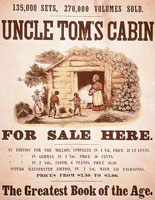
1852 March 20
Uncle Tom's Cabin published.
This novel condemned slavery. By 1879 there were at least forty-nine traveling companies performing Uncle Tom's Cabin throughout the United States.
1855
Abolitionist John Brown and sons moved to Kansas to fight slavery. In 1858 Brown
moved to Virginia and attacked armory at Harpers Ferry.
1857 March 6
Dred Scott v. Sandford.
The Supreme Court ruled that Blacks were not citizens of the United States, and denied Congress the ability to prohibit slavery in any federal territory.
1863 July 18
The Massachusetts 54th Regiment, the first all-Black regiment recruited in the North
to fight for the Union army during the Civil War. Bravely, skillfully, and honorably
the men of the 54th Regiment led the valiant attack on Fort Wagner, SC, on July 18,
1863.
1865 December 18
13th Amendment to the U.S. Constitution ratified, outlawed slavery.
1866 April 9
Civil Rights Bill of 1866 passed.
Congress granted Blacks the rights and privileges of American citizenship. The law formed the basis for the 14th Amendment to the United States Constitution. It was passed over the veto of President Andrew Johnson.
1867 April 1
Ku Klux Klan Convention.
The first national convention of the Ku Klux Klan was held in Nashville, Tennessee.
1868 July 28
Blacks Become Citizens.
14th Amendment to the U.S. Constitution ratified, granting equal protection of the laws to African Americans.
1870 March 30
Black Men Granted the Vote.
15th Amendment to the U.S. Constitution ratified, granting African Americans the right to vote.
1874
In 1874, the McLoughlin Brothers of New York manufactured a puzzle called "Chopped
Up Niggers."
1875 March 1
Civil Rights Bill passed.
Congress prohibited discrimination in public accommodations, including, inns, theaters, public conveyances on land or water, and "other places of public amusement."
As early as 1875
Aunt Sally, a Mammy image, appeared on cans of baking powder.

1878
Blacks As Targets.
In 1878 the C.W.F. Dare Company of New York offered painted "Negro Head Canvases" and "Negro Heads" made of wood since live targets were difficult to obtain. Under "latest novelty games," the 1914 Butler Brothers Catalog listed two target games in which racial aggression and sadism were blatantly obvious. The "Little Darky Shooting Gallery" with its "three comic cardboard targets," one of which was a heavy-set Black woman, came complete with "spring gun and vacuum rubber tipped arrows for $1.95 a dozen." "Darky Ten Pins" featured "ten 6-1/2 inch heavy cardboard litho coons on wood bases," each smiling and holding enormous watermelons.
1879
Exodus of 1879.
Thousands of Southern blacks frustrated with discrimination and poverty in the South emigrated to the West. They met hostility from Western Whites and Native Americans.
1882
Lynch Law.
In 1882, at least 49 Blacks were lynched. According to Tuskegee Institute data, between the years 1882 and 1951, 3,437 Blacks were lynched.
1883 October 15
Civil Rights Reversal.
The United States Supreme Court ruled in Civil Rights Cases of 1883 that the Civil Rights Act of 1875 was unconstitutional. The High Court ruled that the 14th Amendment prohibited states, but not citizens, from discriminating.
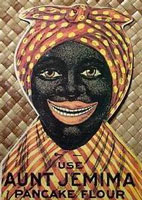
1893
Aunt Jemima Born.
In 1889, Charles Rutt, a Missouri newspaper editor, and Charles G. Underwood, a mill owner, developed the idea of a self-rising flour that only needed water. Rutt called it Aunt Jemima's recipe. Rutt borrowed the Aunt Jemima name from a popular vaudeville song that he had heard performed by a team of minstrel performers. The minstrels included a skit with a southern mammy. Unfortunately for him, he and his partner lacked the necessary capital to effectively promote and market the product. They sold the pancake recipe and the accompanying Aunt Jemima marketing idea to the R.T. Davis Mill Company.
The R.T. Davis Company improved the pancake formula, and, more importantly, they developed an advertising plan to use a real person to portray Aunt Jemima. The woman they found to serve as the live model was Nancy Green, who was born a slave in Kentucky in 1834. She impersonated Aunt Jemima until her death in 1923. Struggling with profits, R.T. Davis Company made the bold decision to risk their entire fortune and future on a promotional exhibition at the 1893 Columbia Exposition in Chicago. The Company constructed the world's largest flour barrel, 24 feet high and 12 feet across. Standing near the barrel, Nancy Green, dressed as Aunt Jemima, sang songs, cooked pancakes, and told stories about the Old South -- stories which presented the South as a happy place for blacks and whites, alike. She was a huge success. She had served tens of thousands of pancakes by the time the fair ended. Her success established her as a national celebrity. Her image was plastered on billboards nationwide, with the caption, "I'se in town, honey."
1896 May 18
Plessy v. Ferguson.
Supreme Court upheld the concept of separate but equal public facilities; thereby, offering approval of Jim Crow laws nationwide.
1898
Little Black Sambo.
Helen Bannerman wrote this controversial book in 1898 in England. It was published in England in 1899, and published in the United States in 1900.
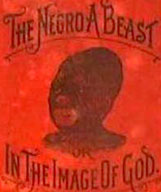
1900
The Negro A Beast.
This book, published by Charles Carroll, claimed that Blacks were more akin to apes than to human beings, and theorized that Blacks had been the "tempters of Eve." Carroll said that mulatto brutes were the rapists and murderers of his time.
1900
117 Blacks lynched in 1900.
1901
105 Black Americans were lynched.
1903
First Black Actor.
In 1903, Edwin S. Porter directed a twelve-minute version of Uncle Tom's Cabin. This was the first Black character in an American film; ironically, a nameless White actor colored with blackface makeup played Uncle Tom. Porter's Uncle Tom, like the Toms on stage, was a childlike, groveling servant.
1905
The Clansman Published.
In this novel, Thomas Dixon described Blacks as "half child, half animal, the sport of impulse, whim, and conceit...a being who, left to his will, roams at night and sleeps in the day, whose speech knows no word of love, whose passions, once aroused, are as the fury of the tiger." The Clansman included a detailed and gory account of the rape of a young White virgin by a Black brute. After the rape, the girl and her mother both committed suicide, and the Ku Klux Klan lynched the Black brute. This book served as the basis for the movie The Birth of a Nation (which also portrayed some Blacks as rapist-beasts), justified the lynching of Blacks, and gloried the Ku Klux Klan.
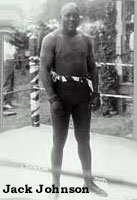
1908 December 26
First Black Heavyweight Boxing Champion.
John Arthur "Jack" Johnson, defeated Canadian Tommy Burns on December 26, 1908, in the World Boxing Championship held in Sydney. This initiated the quest to find a "Great White Hope" to defeat Johnson. James Jeffries, a leading white fighter, came out of retirement to answer the challenge. Jack Johnson won their fight on July 4, 1910. News of Jeffries's defeat ignited numerous incidents of White violence against Blacks. Johnson's reign as champion ended in a controversial loss to Jess Willard on April 5, 1915.
Jack Johnson's two marriages to White women led to harsh criticism, especially in newspapers. Interracial marriages were illegal in many states. Johnson was convicted in 1912 of violating the Mann Act for transporting his wife across state lines before their marriage was finalized, and was sentenced to a year in prison. While out on appeal, Jack Johnson, fearing for his life, escaped. Posing as a member of a Black baseball team, he fled to Canada and later Europe. Jack Johnson remained a fugitive for seven years. Johnson defended his heavyweight championship three times in Paris before his fight with Jess Willard.
In 1920, Jack Johnson decided to return to the United States to serve his sentence. After his release from prison, Jack Johnson's boxing career declined. To make ends meet, Johnson worked in vaudeville and even appeared with a trained flea act.
1909 February 12
National Association for the Advancement of Colored People (NAACP) founded.
1913-1921
Woodrow Wilson segregates the federal government.
1914
Every southern state and many northern cities had Jim Crow laws that discriminate
against Black Americans.
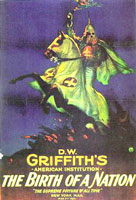
1915
Birth of a Nation.
This movie popularized many anti-Black caricatures, especially the Brute. The movie also gloried the Ku Klux Klan and helped lead to a resurgence of the KKK.
1917
April 17 World War I.
The United States entered World War I. Approximately, 300,000 Blacks saw service during the conflict. Three Black regiments received the Croix de Guerre for valor.
1917 July 1-3 Race Riot
At least forty Blacks were attacked and killed during a race riot in East St. Louis,
Illinois. Three weeks later, some 10,000 Blacks participated in a silent march down
Fifth Avenue in New York City to protest racial oppression, especially riots directed
against Black communities.
1919
Red Summer.
Many Whites, resentful of Black demands for equality, attacked Blacks. Chicago, Houston, Little Rock, Harlem, Washington DC, New York, Baltimore, New Orleans, and many other cities had outbreaks of rioting as Whites attacked Blacks throughout America.
1921
Harlem Renaissance began as a response to interest in African American culture.
1922
The Little Rascals.
The Ten Picaninnies was a forerunner to Hal Roach's Our Gang series -- sometimes referred to as The Little Rascals. First produced in 1922, Our Gang continued into the "talkie era." Roach described the show as "comedies of child life." It included an interracial cast of children, including, at various times, these Black characters: Sunshine Sammy, Pineapple, and Farina in the 1920s, and later, Stymie, and Buckwheat. All the characters were buffoons, but the Black characters were "racial buffoons."
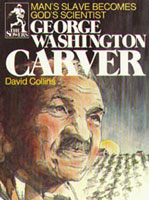
1923 September 4
George Washington Carver Honored.
George Washington Carver, of Tuskegee Institute, received the Spingarn Medal, the NAACP's highest award, for distinguished research in agricultural chemistry.
1923 October
Garrett A. Morgan, a Black inventor, developed the automatic traffic light. Morgan
had earlier invented the gas mask used by American troops during World War I.
1925 August 8
Ku Klux Klan March on Washington.
Founded in 1915 and inspired by the Reconstruction-era organization of the same name, the second Ku Klux Klan shared with its nineteenth-century namesake a deep racism, a fascination with mystical regalia, and a willingness to use violence to silence its foes. It also professed anti-Catholicism and anti-Semitism as strongly as it affirmed racism. The "secret" society had 3 million members during its heyday in the early 1920s; roughly half its members lived in metropolitan areas, and although it enjoyed considerable support in the South, the Klan was strongest in the Midwest and Southwest. Forty thousand members of the Klan marched down Pennsylvania Avenue on August 8, 1925.

1929
The first Coon Chicken Inn was built in 1925 in Salt Lake City. Late in 1929 a second
Coon Chicken Inn was opened in Seattle on Lake City Way Northeast. In 1930 they added
the restaurant on Sandy Boulevard in Portland, Oregon. A cabaret and orchestra were
added to the Seattle and Salt Lake City restaurants. These later restaurants also
had larger dining rooms and delivery trucks for outside catering. Maxon, the owner,
added the famous head logo to the entrances of the inns to attract children. The restaurants
stayed in business until the late 1950s.
1931 April 6
Scottsboro Boys on Trial.
Nine Black boys tried for raping two White women. The defendants were hastily and wrongly convicted, but by 1950 all were free by parole, appeal, or escape.
1933
Other Aunt Jemimas.
In 1933 Anna Robinson, who weighed 350 pounds, became the second Aunt Jemima. She was much heavier and darker in complexion than was Nancy Green. The third Aunt Jemima was Edith Wilson, who is known primarily for playing the role of Aunt Jemima on radio and television shows between 1948 and 1966.
1934
Black Muslims.
Elijah Muhammad succeeded W. D. Fard as leader of the Black Muslim movement.
1934
The movie "Imitation of Life" told the story of a Black maid and her near-White daughter.
The movie was remade in 1959.
1934
Stepin Fetchit.
Fetchit's coon characters were racially demeaned and often verbally and even physically abused by White characters. In David Harum (1934) he was traded to Will Rogers along with a horse. He was traded twice more in the movie. In Judge Priest (1934), he was pushed, shoved, and verbally berated by Will Rogers; even worse, his character was barely intelligible, scratched his head in an apelike manner, and followed Rogers around like an adoring pet. In Black communities, Stepin Fetchit remains a synonym for a bowing and scraping Black man.
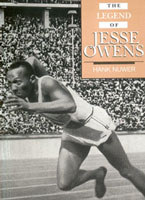
1936 August 9
Jesse Owens became the first American to win four gold medals in one Olympics. His
athletic success was a direct refutation of Adolph Hitler's ideology of Aryan supremacy.
1940
Racist Games.
In 1940, All-Metals Products Co. of Wyandotte, Michigan marketed a "Sambo Target" for use with their toy pistol set. A gap-toothed, bug-eyed young Sambo was the centerpiece of a brightly lithographed, metal target board. In 1945, a game called "The Adventures of Little Black Sambo" used graphics heavily influenced by the illustrations in contemporary editions of the children's book: an African "native" with minstrel-like features and no hair.
1944 April 3
Smith v. Allwright.
The Supreme Court ruled that the "white primary," which excluded Blacks from voting, was unconstitutional.
1944
An American Dilemma.
This book, written by Gunnar Myrdal, critiqued America's racial hierarchy. Jim Crow segregation was presented as a national (even international) embarrassment.

1947 April 10
Baseball's Color-line Broken.
Jackie Robinson joined the Brooklyn Dodgers.
1948 May 3
Shelley v. Kraemer.
The U.S. Supreme Court ruled that lower courts cannot enforce restrictive housing covenants.
1948 July 26
President Truman issued an Executive Order that called for equality of treatment
and opportunity for all Americans in the armed forces.
1950
Gwendolyn Brooks won the Pulitzer Prize for Annie Allen, a volume of poetry. She
was the first African American to win the award.
1950
The television show Beulah, popular from 1950 to 1953, included a mammy who nurtured
a white suburban family.
1954 May 17
Brown v. Board of Education of Topeka, Kansas.
Supreme Court outlawed segregation in all public schools in the United States.
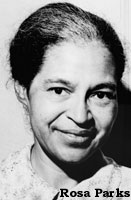
1955 December 1
Rosa Parks.
Her arrest, for violating Jim Crow ordinances, led to a citywide bus boycott, which, in turn, led to the emergence of Martin Luther King, Jr. as a national leader.
1956
Orville Hubbard, Mayor of Dearborn, Michigan, tells Alabama newspaper he is "for
complete segregation, one million percent."
1957 September 25
Little Rock Nine.
President Dwight D. Eisenhower ordered federal troops into Little Rock, Arkansas, after unsuccessfully trying to persuade Arkansas Governor Orval Faubus to give up his efforts to block desegregation at Central High. Faubus, and a mob of Whites, were forced to allow nine children to attend school on September 25.
1960 February 1
Sit-Ins (Greensboro, N.C.)
Four black students from North Carolina Agricultural and Technical College staged a sit-in at a segregated Woolworth's lunch counter. Although they were refused service, they were allowed to stay at the counter. The event triggered many similar nonviolent protests throughout the South.
1961 March 6
Affirmative Action First Reference.
President John F. Kennedy issued Executive Order 10925, which created the Committee on Equal Employment Opportunity and mandated that projects financed with federal funds "take affirmative action" to ensure that hiring and employment practices are free of racial bias.
1961 May 4
Freedom Rides.
The Congress of Racial Equality (CORE) sent student volunteers on bus trips to test the implementation of new laws prohibiting segregation in interstate travel facilities. One of the first two groups of "freedom riders," as they were called, encountered its first problem two weeks later, when a mob in Alabama set the riders' bus on fire. The program continued, and by the end of the summer 1,000 volunteers, black and white, had participated.
1963 June 12
Medgar W. Evers Shot.
A sniper in Jackson gunned down Evers, NAACP field secretary in Mississippi and a World War II hero. The alleged assailant, a White segregationist, was acquitted by a hung jury. In 1994, Byron De La Beckwith was convicted of killing Evers.
1963 June-August
Civil rights demonstrations, protests, and boycotts occurred in every major urban
area in the country.
1963 August 28
I Have A Dream.
The Civil Rights Movement reached its peak when 250,000 Blacks and Whites gathered at the Lincoln Monument in Washington to lobby for passage of a Civil Rights Act. Dr. King delivered his famous speech.
1963 September 15
Four Girls Killed.
Just two weeks after the Washington march, Robert Chambliss threw 15 sticks of dynamite into the basement of the Sixteenth Street Baptist Church's in Birmingham, Alabama. Church services were being conducted and 250 people were in attendance. Four young Black girls, Addie Collins, Carole Robertson, Cynthia Wesley, and Denise McNair were in the changing room of the basement. The blast completely destroyed the building and the four girls lay died in its basement; another 20 individuals were seriously injured. Bobby Frank Cherry was convicted for his part in the bombing on May 22, 2002.
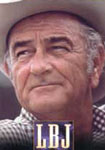
1964 June 4
President's Defense of Affirmative Action.
In an eloquent speech to the graduating class at Howard University, President Johnson framed the philosophy underlying affirmative action, asserting that civil rights laws alone were not enough to remedy the effects of past discrimination:
"You do not wipe away the scars of centuries by saying: 'now, you are free to go where you want, do as you desire, and choose the leaders you please.' You do not take a man who for years has been hobbled by chains, liberate him, bring him to the starting line of a race, saying, 'you are free to compete with all the others,' and still justly believe you have been completely fair . . . This is the next and more profound stage of the battle for civil rights. We seek not just freedom but opportunity-not just legal equity but human ability-not just equality as a right and a theory, but equality as a fact and as a result."
1964 July 3
Lester Maddox's Pickrick.
Maddox and a throng of supporters wielding axe handles forcibly turned away three black activists who tried to eat at Maddox's restaurant, the Pickrick. When a photograph of the acrimonious scene ran on the front page of newspapers across the nation, it created an indelible image of Maddox as a violent racist. It would be a reputation he would both shun and cultivate at various points in his future career. Years later he opened a store in Atlanta's Underground Market and sold autographed ax handles that he called "Pickrick Drum Sticks." Maddox was elected Governor of Georgia in 1967.
1964 July 2
Civil Rights Act of 1964.
President Johnson signed the Civil Rights Act of 1964, making segregation in public facilities and discrimination in employment illegal.
1964 August 4
Civil Rights Deaths.
The bodies of three civil rights workers, two Whites and one Black, were discovered buried near Philadelphia, Mississippi. The FBI accused nearly two-dozen White segregationists of complicity in the murders, including law enforcement officers.
1964 December 10
Martin Luther King, Jr. received Nobel Peace Prize.
1965 January 2-23
Voter Registration Drive, led by Martin Luther King, Jr., opened in Selma, Alabama
and throughout the state.
1965 March 21-25
The fifty-mile march from Selma to Montgomery, Alabama contributed to the passing
of the Voting Rights Act.
1965 August 11-21
Watts Riot.
The Watts area of Los Angeles exploded in violence following the arrest of a young Black motorist. National guards assisted in quelling the disorder; 34 died, more than 1,000 were injured, and 3,952 were arrested.
1966 October
The Black Panther Party founded in Oakland, California.
1967 May 1-October 1
Race Riots.
The worse summer of racial disturbances in U.S. history occurred. More than forty riots were recorded, the most serious outbreaks were in Newark, New Jersey (July 12-17) and Detroit (July 23-30).
1967 June 12
Interracial Ban Lifted.
In Loving v. Virginia, the Supreme Court ruled that prohibiting interracial marriages was unconstitutional. Sixteen states that banned interracial marriage at the time were forced to revise their laws.

1968 April 4
Martin Luther King, Jr. assassinated.
The assassination was followed by a week of rioting in at least 125 cities across the nation, including Washington, D.C.
1968 April 11
President Lyndon Johnson signed the Fair Housing Act, prohibiting racial discrimination
in the sale and rental of most housing units in the country.
1968 November 5
Political Gains.
Shirley Chisholm became the first Black woman elected to Congress. Increasingly, Blacks were elected to political offices in the South. There were 400 elected Black officeholders in the eleven states that made up the Confederacy. By comparison, only 70 Blacks held political office in those states in November 1965, just after the Voting Rights Act took effect.
1970
Resistance to Desegregation.
Throughout the South, Whites rejected desegregation of schools. On March 3, a mob of 200 angry Whites, with ax handles and baseball bats, stormed buses transporting 39 Black children to a formerly all-White school in Lamar, South Carolina.
1970 May 14
Mississippi law enforcement officers killed two young Blacks at Jackson State College.
1970 October 5-November 8
Violent racial clashes connected with school desegregation occurred in Northern and
Southern cities. In Pontiac, Michigan tensions were high after a court decision ordered
desegregation of the public schools. A car near Pontiac Central High School struck
down a Black student on October 7 as White and Black students continued a two-day
battle with rocks and bottles.
1970 August 29
Pondextuer E. Williams, a Black soldier killed in Vietnam, was buried in a "Whites
Only" cemetery. A U.S. judge ordered the cemetery to accept Williams' body for burial.
Following Williams' internment, some Whites who owned plots threatened to remove their
relative's bodies.

1971
Birth of Blaxploitation.
The film that ushered in the blaxploitation period was Sweet Sweetback's Baadasssss Song (1971), written, directed, produced, and starred in by Melvin Van Peebles. The story centered on Sweet, an amoral and hedonistic hustler and pimp, who killed two White cops who were attacking a young Black radical. He spent the rest of the movie on the lam, running from racist cops and to pimps, gangsters, bikers, and whores. Sweet's "revolutionary consciousness" was heightened because of his first hand experience with police corruption, and by the movie's end he was a heroic, almost mythical, Black revolutionary.
1971 April 20
The Supreme Court, in Swann v. Charlotte-Mecklenburg Board of Education, upheld busing
as a legitimate means for achieving integration of public schools. Although largely
unwelcome (and sometimes violently opposed) in local school districts, court-ordered
busing plans in cities such as Charlotte, Boston, and Denver continued until the late
1990s.
1978
Regents of the University of California v. Bakke.
The Supreme Court ruled against fixed racial quotas but upheld the use of race as one factor in making decisions on admissions for professional schools.
1988 March 22
Overriding President Ronald Reagan's veto, Congress passed the Civil Rights Restoration
Act, which expanded the reach of non-discrimination laws within private institutions
receiving federal funds.
1991 November 22
Civil Rights Act.
After two years of debates, vetoes, and threatened vetoes, President George Bush reversed himself and signed the Civil Rights Act of 1991, strengthening existing civil rights laws and providing for damages in cases of intentional employment discrimination.
1992
Los Angeles Riots.
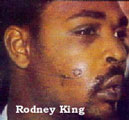
On April 29, 1992, four white L.A.P.D. police officers were acquitted of assault while arresting black motorist Rodney King and Los Angeles residents took to the streets in violent protest. Things got out of control quickly - scores of fires were set, stores were looted - with most of the carnage, like the beating of King, documented on tape. Riots on a smaller scale spread to other U.S. cities, but order was quickly restored.
1997 November 3
Proposition 209 enacted in California.
A state ban on all forms of affirmative action was passed in California: "The state
shall not discriminate against, or grant preferential treatment to, any individual
or group on the basis of race, sex, color, ethnicity, or national origin in the operation
of public employment, public education, or public contracting." Proposed in 1996,
the controversial ban had been delayed in the courts for almost a year before it went
into effect.
Events from 2000 to present day
2000 February 22
Florida banned race as factor in college admissions.
Florida legislature approved education component of Gov. Jeb Bush's "One Florida"
initiative, aimed at ending affirmative action in the state.
2003 June 23
Supreme Court Upheld Affirmative Action in Higher Education.
In the most important affirmative action decision since the 1978 Bakke case, the Supreme
Court (5-4) upheld the University of Michigan Law School's policy, ruling that race
can be one of many factors considered by colleges when selecting their students because
it furthers "a compelling interest in obtaining the educational benefits that flow
from a diverse student body."